Angela Ackerman's Blog: Writers Helping Writers, page 60
September 21, 2021
How Much Do I Need To Describe My Character���s Appearance?
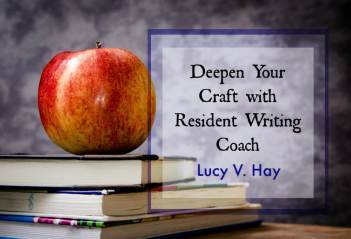
By Lucy V Hay
How characters look is a much-discussed element of writing craft. So, just how much do we need to describe our character���s appearance?
Obviously individual writers��� mileage may vary on this question. Some authors may spend a lot of time on character appearance. Others may do it more intuitively, or leave it almost entirely up to the reader���s imagination.
Coming from a screenwriting background, character appearance is a hot topic with my ���Bang2writers��� because of casting. The ���right��� actor for a character may refer to personality, but also appearance. For example, a LOT of people felt Tom Cruise was entirely the wrong choice for Lee Child���s Jack Reacher character!
With this background in mind then, I am going to offer up my top tips on character appearance in your novel. Ready? Let���s go ���
Beware of ���Laundry List��� Character IntroductionsCharacter introductions are super-important. The first time we ���see��� them, we should get a feel for WHO they are via WHAT they are doing.

In screenwriting, we say ���characters are what they DO��� ��� but too often, writers introduce their characters just by what they���re wearing. I call this the ���laundry list��� character introduction. Yet all of us know ���clothes DON���T make the wo/man���!
Sometimes it won���t be clothes. Instead it may also be the way they wear their hair, how they do their make up or whether they have certain physical attributes. (For example, whether the character has big breasts ��� Yes, you���ve guessed it, female characters fare worst in this).
Yes, what we choose to wear CAN reflect our attitudes (especially strong looks like punk or hippy). But the fact is too many writers use this as a lazy shortcut **on its own**.
KEY TAKEAWAY: Avoid the ���laundry list��� introduction. If you want to use clothes go ahead ��� just don���t rely on them to define the character.
2. Avoid non-stop moving body parts!

So if characters are what they DO, then we should rely on action when thinking about appearance. This Physical Feature Descriptive Database at One Stop for Writers offers some good hints for describing things like a characters��� lips and what they may do to signify different emotions.
However, we���re not out of the woods yet!
Whilst characters physically moving *can* be a good indicator of what they���re going through, we don���t want to rely on it too much either.
When it comes to novel writing, the psychological aspect is very important. If we reduce every character to what they���re physically doing all the time, it can adversely affect the read. Instead of an emotional connection, the reader becomes a voyeur.
This is most obvious when authors write constant actions pertaining to the body, such as ���
Eyebrows risingHands on / off hipsNodding / shaking of headSmiling / grimacingLicking of lipsHands in the air or similar gestures
In other words, constant moving body parts become a ���filler��� or worse, a stand in for actual characterisation. No thanks!
KEY TAKEAWAY: Avoid your characters��� movements becoming ���filler��� by taking the emphasis off their ���smaller��� actions. Use them in moderation instead.
3. Beware the WORD OF DOOM
There���s one word I see too often when I read female character introductions. Guess what it is ���
��� BEAUTIFUL!I call this the ���word of doom���. (BTW, we may also see other variants of this word too, ranging from ���pretty��� to ���sexy���, so nice try but no cigar!).
I���m not alone, either. Check out what this A List actor has to say on the matter.
In fact, the word of doom pops up in the screenwriting world so often there are whole websites devoted to terrible casting calls, such as Miss L���s brilliant but scathing Casting Call Woe over on Tumblr. Here���s another called @femscriptintros.
Authors are not off the hook either. In recent years more and more readers have been calling out novelists for objectifying female characters like this.
Confused?? After all, ���beautiful��� is a compliment, right?
Well, think on it this way. Female characters are often described by HOW THEY LOOK *over* WHAT THEY DO.
Yet if characters are supposed to be what they do, their behaviour is supposed to be what drives them, not how good-looking their appearance is.
Remember, a male lead might often be good-looking too, but they���re still more likely to be introduced by their character traits, than how they look. Gnash!
KEY TAKEAWAY: Avoid falling back on the ���word of doom��� when introducing female characters. Instead of focusing on their appearance, think about their internal character traits and behaviour. Personality before gender (this works for all characters, by the way).
Good Luck!

Lucy V. Hays
Resident Writing Coach
Lucy is a script editor, author and blogger who helps writers at her site, Bang2write.com. To get free stuff for your novel or screenplay, CLICK HERE.
Twitter �� Facebook �� Instagram
The post How Much Do I Need To Describe My Character���s Appearance? appeared first on WRITERS HELPING WRITERS��.
September 18, 2021
Relationship Thesaurus Entry: Boss and Employee
Successful stories are driven by authentic and interesting characters, so it���s important to craft them carefully. But characters don���t usually exist in a vacuum; throughout the course of your story, they���ll live, work, play, and fight with other cast members. Some of those relationships are positive and supportive, pushing the protagonist to positive growth and helping them achieve their goals. Other relationships do exactly the opposite, derailing your character���s confidence and self-worth or they cause friction and conflict that leads to fallout and disruption. Many relationships hover somewhere in the middle. A balanced story will require a mix of these dynamics.
The purpose of this thesaurus is to encourage you to explore the kinds of relationships that might be good for your story and figure out what each might look like. Think about what a character needs (good and bad), and build a network of connections for him or her that will challenge them, showcase their innermost qualities, and bind readers to their relationship trials and triumphs.
Boss and Employee
Description:
Employees work in the goods or service sectors beneath the management of an employer. Whether you work part-time or full-time, fully-contracted or as a consultant, most of us have experience working for an employer. Consider how you might use your own experiences as an employee or an employer to give your characters realistic interactions.
Relationship Dynamics
Below are a wide range of dynamics that may accompany this relationship. Use the ideas that suit your story and work best for your characters to bring about and/or resolve the necessary conflict.
An employee and boss who are friends or even family members outside of the business
An employer recognizing the strengths of their employee and encouraging them to pursue their own goals
A boss soliciting and valuing feedback and new ideas from the employee
A boss treating the employee as a member of the team rather than a cog in the corporate wheel
A relationship in which the employee feels comfortable approaching their employer for any reason
A relationship that is strictly business with no real personal engagement
A boss who is constantly cleaning up the messes up their unprofessional or incompetent employee
A micro-managing employer who shows little trust in the employee
An employee who doesn’t think much of their boss and shows no respect
Either party being afraid of the other (because one party is tied to someone powerful, one has made threats against the other, etc.)
Either party feeling stuck, wanting to end the relationship but being unable to
An immature or rebellious employee who is always making trouble for the employer
An employee and boss with baggage from a former relationship (them being former rivals, lovers, etc.)
Challenges That Could Threaten The Status Quo
The employer needing to downsize their business
A financial downturn that results in the employee not being paid consistently or regularly
The business moving to a different location
The employee causing an accident or disaster at their place of work
The boss getting caught breaking terms of their employment
The employer giving the employee a bad performance review
The employee discovering the business’s involvement in illegal activity
The employer setting the employee up to fail
The employee funneling information about the business to a competitor
The boss asking the employee to keep a difficult secret
The employee���s personal beliefs conflicting with new company policies
The parties developing a relationship outside of the workplace
The boss showing preference to the employee over other workers
The employee asking the employer for favors (hiring a family member, advanced pay, etc.)
The boss turning down the employee���s request for a raise
The employee needing to telework or call out sick for personal reasons
The boss criticizing the employee in front of others
Either party being accused of discriminatory or abusive behavior in the workplace
The employer changing the terms of the employee���s contract
Discovering a personal connection through a third-party
Conflicting Desires that Can Impair the Relationship
Either party wanting control over the other person
The employee wanting a raise that the employer cannot or will not give them
One party wanting to follow the law while the other does not
The employer wanting the employee to quit
The employee wanting a different role within the company while the boss wants them to stay where they are
The employer wanting more work out of the employee than is feasible
The employee wanting understanding and empathy from an emotionally detached employer
The boss wanting the employee to work unusual and undesirable hours
Either party wanting a romantic relationship with the other
The employer wanting what���s best for the company while the employee wants to do as little as possible
The two parties having a different vision or goal for the company
Clashing Personality Trait Combinations
Analytical and Empathetic, Bold and Cautious, Mature and Irresponsible, Independent and Needy, Controlling and Rebellious, Ambitious and Lazy, Nurturing and Withdrawn, Organized and Disorganized, Confrontational and Timid, Dishonest and Honorable, Decisive and Indecisive
Negative Outcomes of Friction
Feeling anxious about going to work
Feelings helpless or isolated
Being embroiled in a lawsuit
Decreased productivity at work
Being threatened, abused, or blackmailed
Losing colleagues who used to be friends
Being unfairly reprimanded
Loss of pay or employment
Receiving a bad reference for a future employer
Losing the opportunity for a mentorship
Developing a bad professional reputation
Difficulty working with others and being a team player
Having to find a new job and start over elsewhere
Fictional Scenarios That Could Turn These Characters into Allies
The employee defending the employer against false accusations by a third-party
Either party helping the other through a difficult time in their personal lives
Working together on a joint business venture
Surviving a difficult experience together
Finding a way to save the business together
The employee identifying ways to help the business grow and adapt
Combining ideas to surpass the achievement of a competing business
A shared mistake that must be covered up
Being recognized for one���s efforts in the workplace
The employee covering for the boss and saving them from humiliation or negative consequences
Ways This Relationship May Lead to Positive Change
The boss learning to listen to their employees and value other people’s ideas
Either party learning the value of cooperation and compromise
The employer helping the employee take a leap of faith and achieve an important goal
The employee learning to take direction
The relationship resulting in either party becoming better at their job
One party being inspired in some way by the other person, leading to personal growth
Either party learning to accept help
Both parties gaining confidence through success
Themes and Symbols That Can Be Explored through This Relationship
A fall from grace, Betrayal, Deception, Greed, Inflexibility, Journeys, Knowledge, Order, Perseverance, Pride, Recognition, Sacrifice, Stagnation, Teamwork, Transformation, Unity, Vulnerability, Wealth
Other Relationship Thesaurus entries can be found here.
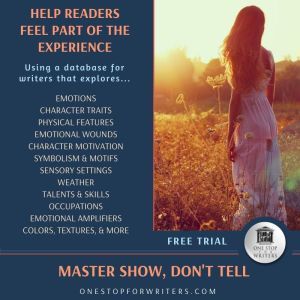 Need More Descriptive Help?
Need More Descriptive Help?While this thesaurus is still being developed, the rest of our descriptive collection (15 unique thesauri and growing) is accessible through the One Stop for Writers THESAURUS database.
If you like, swing by and check out the video walkthrough, and then give our Free Trial a spin.
The post Relationship Thesaurus Entry: Boss and Employee appeared first on WRITERS HELPING WRITERS��.
September 16, 2021
Choosing Your Fiction Genre: The 3 Things You Should Consider First��
Guest Poster: Christina Kaye
A big hello and welcome to Christina Kaye–an editor, author, and coach all rolled into one. She’s here to help us make a big decision: which genre to write in. Read on!
According to Statistica.com, by the end of 2020, the contemporary fiction genres which sold the greatest number of books were romance (over 9-million book sales) and suspense/thrillers (over 10 million book sales).
That���s just in units sold. When a recent study done by BookAdReport.com factored in the cost per each book by genre, something interesting happened. See the chart below.
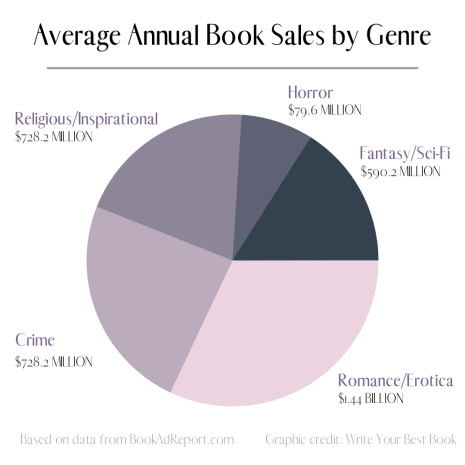
Interestingly, religious/inspirational books almost tied with romance/erotica and crime novels in total average yearly book sales!
Why am I throwing statistics at you? Because it brings to mind for me an interesting, never-ending struggle many authors face and some even love to debate.
Should we be writing stories about what we know and love? Or should we choose the type of stories we write based on what is popular or ���marketable��� at any given point in time?��It���s an interesting question, and many authors have a strong opinion one way or another. But, especially for new authors, the answer may not come to us so easily.
Unfortunately, I can���t tell anyone which genre or types of stories they should write. It���s a decision each author must make for themselves. But in this post, I���m going to give you some facts, figures, and points to consider, so you can make a well-informed decision that is best for you.
Tip #1 – Determine Your Overall GenreIf you searched the internet for the main types of genres and how many there are, you���ll get answers that vary stupendously. In fact, I just ran a quick search myself, and here are just a few of the answers Google gave me on page one alone as to how many genres exist in fiction:

No wonder new writers feel confused and intimidated over this!
Most people agree, however, that the following represent the most common and most popular genres of fiction, and most fiction stories can fit into at least one:
Crime (mystery, thriller, suspense)RomanceFantasyScience FictionWomen���s FictionParanormalLiteraryHorrorDystopianAdventureHistoricalLGBTQABut figuring out which main genre your story will fall into is just the first step. Considering there are BILLIONS of books that exist in the world (and anywhere from 7 to 144 genres to divide them into), that still lands you in a really large pool of ���similar��� books. And it���s important to be as specific as possible when describing your book.
The reason? It���s two-fold.
Knowing your genre inside and out, as well as the expectations readers/fans of that genre hold will help you meet those expectations and craft a story your readers will rush to purchase.Being familiar with your genre and the audience of fans who adore that genre will help you create a more targeted (and effective) marketing campaign because you���ll be keeping your target audience in mind. Tip #2 – Decide Which Subgenre Fits BestSubgenres are the subcategories of each fiction genre that essentially help you ���niche down��� your book into a more specific grouping.
The possibilities are endless, especially when you consider that some really well executed books can slip between genres.
The more familiar YOU are with your story���s genre and its reader expectations, the easier it will be for you to craft the perfect story for them and find them when it comes time to market you book!
Here���s a graphic that shows just some of the subgenres that fall under the three most popular genres: crime, romance, and fantasy.
 Tip #3 ��� Decide Which Genre You Want to Write
Tip #3 ��� Decide Which Genre You Want to WriteNo one can decide this for you, but my best advice is to stop trying to DECIDE which genre you want to write. Instead, clear your mind, and just think about the types of stories you enjoy the most. When you watch TV, listen to podcasts, or read books, which genres do you tend to gravitate toward the most?
For example, when I first decided to write novels and aim for a career as an author, I made ALL the most common mistakes many new authors make. I dove right in and started writing, rather than taking the time to learn everything I could about the craft of writing, publishing, and book marketing.
But once I realized that doing the same thing over and over again but expecting different results was the absolute definition of insanity, I stopped, rewound, and started again from the very beginning.
And when it came time to finally choose what type of stories I wanted to write, I did exactly what I just told you to do. I thought about it and realized that, although I enjoy a little bit out of each genre, crime stories really were my jam.
Once I made the decision to write what I knew and enjoyed most, things finally started happening for me. And I truly believe that, had I not stopped, slowed my roll, then moved forward more intentionally and more purposefully, I would not have been able to cross off so many things from my ���author bucket list.���

So, if you���re not already certain of your genre and what type of stories you want to write, stop and think about it first, then, when you���re ready, choose the type of stories that speak to you, feel right to you, and that you know will come easier and more naturally.
Whatever you do, do not choose your genre solely based on what is ���trending��� at that time. At the end of the day, if you aren���t in love with your story, your readers won’t be either.
I have something that will help you with all the aspects of planning and preparing for writing your next novel.
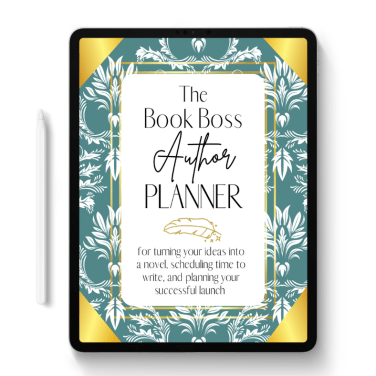
To help you take those first, intentional steps toward writing your best possible book, check out my latest project, available on our website now. The Book Boss Author Planner (digital version) is a comprehensive writing tool I created to walk authors through each and every step you must take to be successful, from idea brainstorming all the way through your book launch.
It comes with all the standard pages you���d expect in a planner and so much more. I���ve packed the 210-page planner full of writing tutorials, worksheets, templates, trackers, and even a list of the best resources available to help you along your writing journey. Visit this link for more information.
Do you ever struggle when it comes to choosing a genre? Let me know in the comments!
Christina Kaye is an author coach, book editor, and public speaker, as well as the Founder and CEO of Write Your Best Book. She mentors, supports, motivates, and encourages authors to write their best book possible. Christina Kaye is also an award-winning, bestselling suspense novelist in her own right.
For daily writing inspiration, tips, and advice, follow her on Tik Tok, Instagram, Facebook, Pinterest, and LinkedIn: @writeyourbestbook
The post Choosing Your Fiction Genre: The 3 Things You Should Consider First�� appeared first on WRITERS HELPING WRITERS��.
September 15, 2021
One Day Only: The Emotional Wound Thesaurus is .99����
Hi everyone! Today’s post is just a quick heads up to let you know The Emotional Wound Thesaurus is Amazon’s Daily Kindle Deal and only a buck. (Affiliate link – thanks for keeping our lights on)
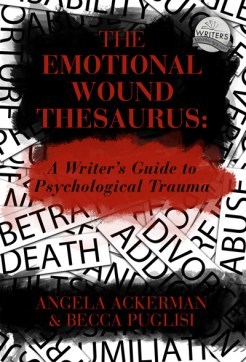
I know, emotional trauma sounds a bit dark.
And it is…which is exactly why we need to understand how to use it in storytelling.
In the real world, painful events are not forgotten. They leave a mark. They change us, causing fears to take hold, trust issues to develop, and push us to avoid people and situations that could reawaken our hurt. They also can hold us back in small and big ways, leading to unhappiness and unmet needs.
They will cause your character a great deal of strife, too.
If your story involves an inner transformation–good or bad–you need to know what your character’s unresolved emotional wounds are. They will have a big role to play in character arc, and will help steer their actions, choices, and decisions.
The better we know our characters, the easier they are to write and the more authentic their behavior and beliefs will feel to readers. So if you need help with formative backstory and understanding how it will influence the story, check The Emotional Wound Thesaurus out!
While I have you here…
A new thesaurus writing guide is coming: The Conflict Thesaurus: A Writer’s Guide to Obstacles, Adversaries, and Inner Struggles (Vol 1). Like all our books, it takes a deep dive into conflict and how to maximize it to build tension, challenge characters as they traverse their arcs, raise the stakes, and keep readers emotionally invested right up to the end.
This guide profiles an array of obstacles, challenges, problems, ticking clocks, no-win scenarios, temptations, moral struggles and more, helping you to plot a story worthy of your character.
ARC reader sound bites:“A priceless resource for any writer…”
“Full of potential conflict and plot ideas…”
“Everything a writer needs to strengthen story conflict…”
“So much more than just a “thesaurus”. It’s a tutor, a guide, and a writing mentor all crammed into one…”
“Angela and Becca have done it again���and left no conflict stone unturned…”
More about the book
Master list of conflict scenarios
Add it to your Goodreads list
This book releases October 12th, and while there is no preorder, if you add your name to this list, we’ll send you a notification the moment it’s available!
Have a great day, everyone!
The post One Day Only: The Emotional Wound Thesaurus is .99���� appeared first on WRITERS HELPING WRITERS��.
September 13, 2021
Story Not Behaving? Try Going Deeper into Structure
RWC Coach Jami Gold
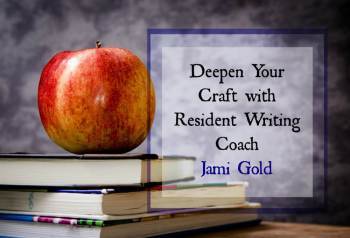
With all the writing advice out there, we know that some ���writing rules��� we hear are more like guidelines. However, story structure is important not just for our writing but also for our readers���creating their overall sense of our story���so we should consider the risks before ignoring structure-specific guidelines.
In fact, if our story isn���t working well, we might be able to fix the issue by going deeper into the reasons behind those guidelines. Let���s take one example of a relatively minor aspect of story structure (that most advice doesn���t even mention) and look at how it can affect our story���and how our story can ���break��� if we fail to include the details readers need.
Story Structure at the 25% MarkBefore we start, first know that different story structure systems use different names for each point, but the function they fulfill for our story is the same. In other words, the names don���t matter.
For example, most story structure systems include a plot event (a story ���beat���) around the 25% mark (often called the Catalyst, First Plot Point, or the End of the Beginning), and no matter the label used, the function of this beat is to create a ���point of no return��� forcing the protagonist into the story.

After this plot event, readers should have at least a hint of (and in many cases, a fairly good idea of):
the story goal(s) and reasons for the goal (stakes)the main conflicts/antagonists/obstacles blocking that goalsome of the internal issues complicating that goalThose all work together to tell readers who they���re rooting for or against, what they���re rooting for or against, and what our story is about.
If we fail to include a story beat with this function around the 25%-ish mark (usually between 20-30%), our story���s pace will likely feel slow and/or readers might close the book in frustration at not understanding the point of the story. A well-developed 25%-mark beat will establish the story, plot, conflicts, stakes, and character/emotional arcs of the story.
Internal Issues at the 25% MarkThose of you familiar with story structure probably expected those first 2 bullet points above, but maybe the last point was a surprise. Many story structure systems and beat sheets focus on the external issues of our story���plot, antagonists, villains, obstacles, etc.���and don���t touch on internal issues.
However, if we comprehend the deep, underlying purpose of a story���s structure at this 25% mark, we know that we want to not only show the goal our characters are aiming for, but also to at least hint at what���s preventing them from reaching that goal right now. After all, without something standing between our characters and their goal, readers will think our story would be over before it began. *grin*
For some stories, that ���something��� will be all about external obstacles and villains, just like the focus of most beat sheets. But for the remainder of stories (especially those with character arcs), readers should have seen hints by the 25% mark that the ���something��� also includes internal obstacles���such as characters��� false beliefs and backstory wounds���that interfere with the story goal(s) as well.
Going Deeper Helps Our Story (and Readers)What���s a reader���s experience if they don���t see (at least) hints of the internal obstacles that will be complicating the protagonist���s path toward the goal(s)?
Readers may think the external conflicts aren���t enough of an obstacle to the goal to create a story and simply close the book.Readers may question whether there���s anything other than a need for word count holding the character back from their goal (in a ���the character struggles because the plot needs them to��� problem) and lose patience with the story and characters.Negative character traits without a hint of an internal-arc goal to improve may be assumed to be permanent, which can make readers less likely to root for them.Any self-destructive (or obviously wrong) assumptions a character makes without a hint of how it ties into their internal arc (such as through a false belief or backstory wound) may make them less likable or sympathetic and lessen readers��� engagement with our story and characters.For example, let���s take a character who assumes no one likes them. If readers have seen evidence throughout the first act that the assumption isn���t true, they might have a negative impression of the character for making such a patently false assumption. The assumption could even make readers frustrated, contemptuous, and dull their emotional connection to our character���and story. Not good.

One potential fix? By the 25%-ish mark, give readers hints/glimpses/allusions to a backstory wound causing that assumption.
Even just a few words hinting at something (such as: He���d learned his lesson about trying to make friends years ago.) can make all the difference between a character that readers sympathize with and a character that readers disdain. The hints give a reason for the character���s internal issues that keeps readers in their corner���and rooting for them to improve.
Story Structure MattersJust as our story can look ���broken��� if we haven���t provided glimpses of enough conflict (external and/or internal) by the 25%-ish mark, similar problems can occur if we ignore the other major story structure guidelines or fail to go deep enough into the purpose behind each major story structure point. Story structure matters for creating the overall sense of our story���and for convincing readers that their time will be rewarded with a satisfying story.
So if we struggle with a story that seems broken, try going deeper into its structure and make sure to address the underlying purpose of each major beat in our story. We may discover a few easy edits to fix our story. *smile*
Do you have any questions or insights about story structure and how going deeper might help our story? Jami Gold
Jami GoldResident Writing Coach
After muttering writing advice in tongues, Jami decided to put her talent for making up stuff to good use. Fueled by chocolate, she creates writing resources and writes award-winning paranormal romance stories where normal need not apply. Just ask her family���and zombie cat. Find out more about Jami here, hang out with her on social media, or visit her website and Goodreads profile.
Twitter �� Facebook �� Pinterest
The post Story Not Behaving? Try Going Deeper into Structure appeared first on WRITERS HELPING WRITERS��.
September 12, 2021
Writers, Do You Struggle with the Learning Curve?

We all had a ‘first step’ in our writing journey. In my case, I signed up for a mail-in writing course (yes, “mail-in.” This was a long time ago.). They paired me with a mentor; I would turn in assignments to him, and he’d offer suggestions for improvement and words of encouragement.
When I completed the course and got my certificate, I was SURE my author career was about to launch. All I had to do was find out how to submit these ‘wonderful’ stories I’d written during the course…how hard could it be?
Since I knew nothing about publishing, I joined a few writing forums. I discovered publishing was competitive, and many writers would use critique partners to help them get their stories as strong as they could be before submitting. So, I joined the Critique Circle. Soon after, I met Becca – we clicked right away, and worked to help each other improve. We decided to study writing craft together and as you know, eventually went on to publish the Emotion Thesaurus.
But between joining the Critique Circle and creating one of the best-loved guides out there, I almost quit.It was the learning curve. It seemed like no matter how much I knew, it was never enough. There was always more.

As I learned from other writers at the Critique Circle I could see I had a long way to go. That was okay, I was ready to put the work in. And I did, studying, critiquing others, writing more stories. I grew my craft.
Eventually I queried, got an agent, left them after a time, got another, went to acquisitions. And repeat, repeat, repeat. I became stuck in a close-but-not-quite loop, and it did a number on my head. I started to doubt myself. I thought something was wrong with me–I wasn’t smart enough, or creative enough. Maybe this writing thing wasn’t meant to be.
(I’m guessing some of you can relate to my story.)
Thankfully, today the landscape is different. We have more than one path to publishing, and a successful career is more in the hands of the writer than gatekeepers. But one thing that remains the same is the learning curve. A compelling story has a lot of moving parts, and there’s a lot to know. It’s easy to get frustrated when we hit a gap in our knowledge.
At some point, the weight of what we’re trying to do hits us, and it can be soul crushing to realize just how much we DON’T know about storytelling. Some flirt with giving up. Others do.
And the rest? They soldier on, because they can see the forest for the trees.
Storytelling is an art. It takes time to be good at it.With any career, there’s a learning curve. No one expects to walk out of med school after a year ready to do brain surgery. Yet as writers, our expectations are sky-high. We irrationally can feel like if we don’t master everything quickly, something is wrong, and we’re the problem.
This mindset can do a lot of damage, and it’s why I almost quit. I hadn’t yet learned the most important lesson of all: writing, like all creative careers, means ongoing education. There will always be more to learn, new ways to grow our insight and skills. And that’s a GOOD THING. It means we’ll never peak. We’ll always have a better story ahead. And that’s pretty exciting, don’t you think?
What’s the best shortcut for the learning curve?
Well…there are no shortcuts. We must all learn what we need to, and it will take as long as it takes. But there are ways to “shorten” the learning curve. Investing in the right help and seeking out the best sources of information can keep us focused and on task. Thankfully there are many great books, resources, mentors, tools, and more out there. One of the best all-round places to start would be this page.
I mentioned earlier that shortly after we met, Becca and I began studying writing craft together. We actually took a year off from writing fiction to tandem study the best writing guides out there, and it gave us a terrific foundation of knowledge. Since then, we’ve continued to be students of the craft, reading and experimenting. We’ve also taught and mentored, passing on the best lessons we’ve learned to others.
And now we’ve created a system for planning, writing, and revising a novel: a Storyteller’s Roadmap. It’s full of expert advice, hard-won lessons, tools, checklists, and more, taking you from that first idea to a publish-ready manuscript.

This is our answer to “How can I shorten the learning curve?” because we supply the information you need as you need it. We also direct you to the best resources to help you at each step, so you’re never wasting time looking for help or wondering what tool to use.
Our intention with this roadmap is that the more you use it, the more you sharpen your skills, and that means delivering even better stories to readers. And that’s what it’s all about. If you’re interested, here’s more about our Storyteller’s Roadmap and One Stop for Writers site. (TIP, use this 30% off code: CONFLICT until September 20th.)
Can you go it alone and be a successful author?Absolutely! It just will take a bit longer simply because there’s so much to know about writing, publishing, and marketing, and so this means more researching and trial-and-error. Reaching out to others to benefit from their wisdom and experience shortens the learning curve.
What’s something you’ve done that really helped with the learning curve? Let us know in the comments!The post Writers, Do You Struggle with the Learning Curve? appeared first on WRITERS HELPING WRITERS��.
September 9, 2021
The Conflict Thesaurus Is at One Stop for Writers
Hi everyone! Just a quick post today to let our One Stop for Writers users know that the Conflict Thesaurus is live at the site. This database is all about causing problems for your character, and is filled with possible challenges, obstacles, moral dilemmas, no-win scenarios, ticking clocks, and more, giving you endless ways to load your story with tension and conflict.

The Conflict Thesaurus book releases in a month, but maybe you need help NOW, which is why we activated it at the site.
Is the Conflict Thesaurus at One Stop for Writers different from the book?Yes! At One Stop we have the ability to expand each entry because we aren’t limited by a page count, so we do. We also can easily add additional conflict scenarios, so you’ll find 15 or so more entries in this database already. (Thank you, technology!)
Not a Member? Now’s a Great Time to JoinWriting is hard, and there is no easy button. But if you’re a fan of our books, you know the RIGHT TOOLS can make all the difference. So if you would like to…
Write without frustration
Feel more productive
Have the expert guidance you need
And see your writing grow stronger and stronger
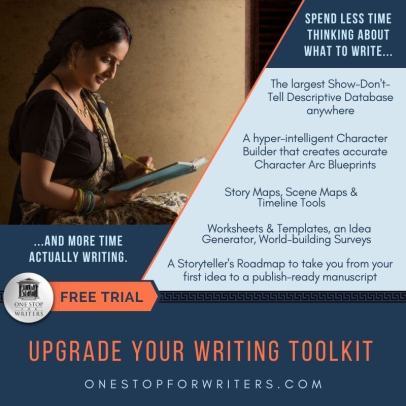
Come by One Stop for Writers and give the Free Trial a spin. We’ve spent the last seven years turning this site into a powerful storytelling portal that has all the tools, resources, and guidance you need to write books that stand out.
And don’t forget, if you need story coaching help, the new Storyteller’s Roadmap is a book plan and story coach, all-in-one. (We’ve had a lot of writers tell us they don’t know how they wrote without it.)
If you decide to subscribe, let us save you some money. Add this one-time code:
CONFLICTAnd receive a 30% discount off any plan.
ONE STOP FOR WRITERSCancel any time. Code expires September 20th.
One Stop for Writers can help you no matter what stage you are at–planning, writing, or revising. We hope to see you there!
The post The Conflict Thesaurus Is at One Stop for Writers appeared first on WRITERS HELPING WRITERS��.
September 7, 2021
Want Success? Get Back to Joyous Writing
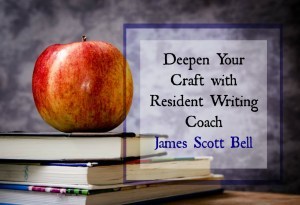
By James Scott Bell
���Things were tough at the moment. I hadn’t worked in a studio for a long time. So I sat there, grinding out original stories, two a week. Only I seemed to have lost my touch. Maybe they weren’t original enough. Maybe they were too original. All I know is, they didn’t sell.���
~Joe Gillis (William Holden) in Sunset Boulevard
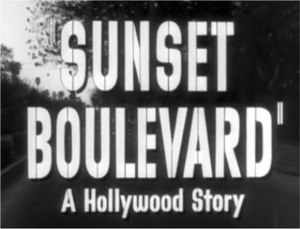
Ah, poor Joe. We can feel his pain (not really, since he���s narrating this as a corpse floating in a swimming pool. But I digress). Still, I love how screenwriters Billy Wilder and Charles Brackett captured the writer���s dilemma���what should I write that has a decent chance to sell?
For writers still operating in the world of traditional publishing, that question is more important than ever. Publishing companies are being squeezed and must concentrate on big hits to survive. This makes it harder for a newbie to break in or, if they manage to get ushered through the gates of the Forbidden City, to receive what used to be called a ���decent advance��� and marketing support.
Indie writers must be market-conscious, too, as the crush of content and reading choices grow ever larger. If you want to make decent scratch you have to provide products (plural) that a good number of people will want to buy.
The danger, of course, is the temptation to jump on a trend or try to replicate what���s already been done. But demanding readers don���t want something that feels same-old. They want to be delighted, surprised, swept up. So do acquisitions editors.
They all want originality. Just not so much that they can���t figure out what ride they���re on.
Which reminds me of the famous quip by Samuel Johnson who had been asked to review a manuscript. He wrote, ���Sir, your book is both good and original. Unfortunately the parts that are good are not original, and the parts that are original are not good.���
Um, ouch.
(As long as we���re on the subject of literary snubs, I can���t help but quote what is reputed to be the shortest book review ever, attributed to Ambrose Bierce: ���The covers of this book are too far apart.���)
So how could we have helped Joe Gillis? Where is the sweet spot for the writer who needs to sell in order to get his car out of hock? It���s where you find the most joy. Way back in 1919, a professor of writing at Columbia University, Clayton Meeker Hamilton, said this:
“In the great story-tellers, there is a sort of self-enjoyment in the exercise of the sense of narrative; and this, by sheer contagion, communicates enjoyment to the reader. Perhaps it may be called (by analogy with the familiar phrase, ���the joy of living���) the joy of telling tales. The joy of telling tales which shines through Treasure Island is perhaps the main reason for the continued popularity of the story. The author is having such a good time in telling his tale that he gives us necessarily a good time in reading it.” (A Manual of the Art of Fiction)
I think Professor Hamilton nailed it. When an author is joyous in the writing, it pulses through the words. When you read a Ray Bradbury, for instance, you sense his joy. He was in love with words and his own imagination, and it showed.
���For the first thing a writer should be is������excited,��� writes Bradbury in Zen and the Art of Writing. ���He should be a thing of fevers and enthusiasms. Without such vigor, he might as well be out picking peaches or digging ditches; God knows it���d be better for his health.���
���Let her go!��� says Brenda Ueland in If You Want to Write. ���Be careless, reckless! Be a lion, be a pirate!���
You liked to play those things when you were a kid, right? So play! Here are three ways to do it:
 Go to Risky Places
Go to Risky PlacesBungee jump off the Bridge of Banal. The cord of a solid premise will keep your from crashing into the gorge.
Have Fun with Minor CharactersMake them spicy, not mere walk-ons. Never underestimate the power of comedy relief in a thriller. Alfred Hitchcock did it in almost every film (e.g., Thelma Ritter in Rear Window; Hume Cronyn and Henry Travers in Shadow of a Doubt).
Make Things Harder on the Main CharacterYou thought that setback was bad? Make it worse. This form of joy is not veiled sadism; it���s plot happiness! Readers will love you for it.
 James Scott Bell
James Scott BellResident Writing Coach
Jim is the author of the #1 bestseller for writers, Plot & Structure, and numerous thrillers, including Romeo���s Rules, Try Dying and Don’t Leave Me. His popular books on fiction craft can be found here. His thrillers have been called “heart-whamming” (Publishers Weekly) and can be browsed here. Find out more about Jim on our Resident Writing Coach page, and connect with him on
Twitter
The post Want Success? Get Back to Joyous Writing appeared first on WRITERS HELPING WRITERS��.
September 4, 2021
Relationship Thesaurus Entry: Enemies
Successful stories are driven by authentic and interesting characters, so it���s important to craft them carefully. But characters don���t usually exist in a vacuum; throughout the course of your story, they���ll live, work, play, and fight with other cast members. Some of those relationships are positive and supportive, pushing the protagonist to positive growth and helping them achieve their goals. Other relationships do exactly the opposite���derailing your character���s confidence and self-worth���or they cause friction and conflict that leads to fallout and disruption. Many relationships hover somewhere in the middle. A balanced story will require a mix of these dynamics.
The purpose of this thesaurus is to encourage you to explore the kinds of relationships that might be good for your story and figure out what each might look like. Think about what a character needs (good and bad), and build a network of connections for him or her that will challenge them, showcase their innermost qualities, and bind readers to their relationship trials and triumphs.
Enemies
Description:
More than rivals or competitors, enemies are people who are actively working to defeat or destroy the other. The reason for their animosity may be personal, stemming from a shared past experience, or it may simply be a matter of them working at cross-purposes and blocking each other from reaching their respective goals. The richness in this relationship comes from the fact that both parties believe in their own rightness. Writing a dynamic and interesting pair of enemies requires a carefully exploration of the relationship’s complexity so they don’t veer into clich��, unsympathetic, or flat-character territory.��
Relationship��Dynamics
Below are a wide range of dynamics that may accompany this relationship. Use the ideas that suit your story and work best for your characters to bring about and/or resolve the necessary conflict.��
Enemies who are both seeking the same resource or objective, and defeating the other party is a necessary part of their success
Two people who are actively seeking to destroy one another
Enemies who used to be friends or allies, with a shared history
Enemies who are part of the same team but are secretly working against each other
Challenges That Could Threaten The Status Quo
One person asking for a truce
One party being taken out by a serious illness or injury
A powerful third-party demanding an end to the feud
One party discovering a damning secret about the other
The two being physically trapped in the same space
Both parties losing something of value
A common enemy entering the picture��
One party joining forces with a stronger and better connected person or entity, disrupting the balance of power
One person having an epiphany about past mistakes or their role in the relationship
One person seeking forgiveness in order to heal
Clashing��Personality Trait��Combinations
Cautious and Reckless, Unethical and Honorable, Confrontational and Timid, Perfectionist and Talented, Mature and Irresponsible
Negative Outcomes of Friction
Anxiety and depression
Arguments and fights
Self-blame for not handling the situation better
Publicly trashing one another
Difficulty trusting others
Becoming fixated on defeating the other person
Missing important events because the other person will be present
Losing friends and family members who take sides
The animosity escalating into abusive or violent behavior
Seeing no way out of the conflict
Being targeted by the friends and family members of one���s enemy
Fictional��Scenarios That Could Turn These Characters into Allies
Both parties realizing they have a common goal
Both parties needing to keep a secret
A business venture or financial opportunity that requires both to participate
An event that forces the two into close proximity (a family reunion, them being held hostage or getting lost together, etc.)
Putting differences aside to present a united front against a more threatening enemy
Discovering that the feud was based on a lie
One party altering their religious, political, or cultural beliefs
Romantic feelings developing between the two
A third-party encouraging reconciliation
Ways This Relationship May Lead to Positive Change
The character recognizing their role in the relationship and taking accountability for their actions
The enemies breaking a cycle of hatred
One party learning to seek and extend forgiveness
Either person learning to see the situation from the other’s perspective
The character recognizing unhealthy thought patterns and behaviors
Either party refusing to engage with their enemy, thereby diffusing the situation
Themes and Symbols��That Can Be Explored through This Relationship
A fall from grace, Betrayal, Danger, Death, Deception, Friendship, Inflexibility, Isolation, Journeys, Love, Peace, Suffering, Violence
Other Relationship Thesaurus entries can be found��here.
 Need More Descriptive Help?
Need More Descriptive Help?While this thesaurus is still being developed, the rest of our descriptive collection (15 unique thesauri and growing) is accessible through the One Stop for Writers THESAURUS database.
If you like, swing by and check out the video walkthrough, and then give our Free Trial a spin.
The post Relationship Thesaurus Entry: Enemies appeared first on WRITERS HELPING WRITERS��.
September 2, 2021
Does Your Story Need More Conflict? Tap this Powerful Source
Conflict is such a versatile storytelling element. Not only will obstacles, adversaries, and stressors keep tension high and readers focused, they also provide characters with valuable opportunities to prove themselves, chances to reexamine what they believe and want, and even failures that teach lessons and beget growth.

Every scene needs good, solid conflict. It might be something big and life-altering, or a smaller block, complication, or disruption the character must now navigate. No matter what form it takes, conflict should further the story and offer readers insight into the characters involved.
Conflict is a kaleidoscope, offering a million possibilities for fresh storytelling. But sometimes, too much choice is paralyzing, and we struggled to choose what happens next. Or we’re writing on a day when the ol’ imagination tank is empty. In these cases, knowing where to look for conflict can guide us to scenarios that help raise the stakes and mess up the protagonist’s plans.
The #1 Place to Find Conflict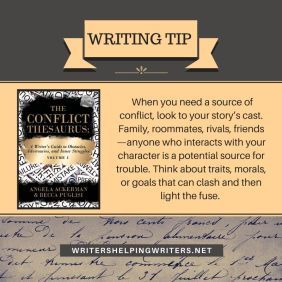
Where does most of our conflict come from in real life? That���s right: other people. Loved ones, extended family, roommates, co-workers, neighbors, friends, complete strangers���if they���re someone who will interact with your character, they���re a potential source for trouble. This is why planning your story���s cast ahead of time can be so beneficial.
Relationship Status: It’s ComplicatedChances are, your character is connected to a variety of people in the story. When you need conflict, poke at their relationships to see what problems shake loose.
MARRIAGE AND PARTNERSHIP: All romantic relationships have bumps – good ones, and bad ones. I’ve been married twenty-seven years and there are days…well, you know. Life can be full of unknowns, including whom each person will become, how beliefs, goals, and needs may change, and if the partners will grow mostly in the same direction or not. People can also cope very differently when it comes to life’s challenges, and this can lead to resentment, frustration, friction, and fallout.

FAMILY: The people closest to your character may know things others do not…including the bad stuff. Past mistakes, shortcomings, and failures may be part of a relative’s mental Rolodex. Will they reference a “favor owed” when they want something, lay a guilt-trip, or spill a secret to others when they’ve had too much to drink? Strings tend to be attached in family relationships, so responsibilities, duties, expectations, and demands might also be a source of friction. And let’s not forget family dysfunction! Disagreements, arguments, sibling rivalries, or a family feud might help you hit your character’s soft spots.
HISTORY: Think about what kinds of people might have crossed swords with your character at some point in the past. Did your character wrong someone, or did betrayal end a friendship? What will happen if a ghost from the past shows up at a time when your character needs to really focus on the present?
Or maybe your character did something they aren’t proud of. If the partner from a one-night affair appears at the family barbecue as a cousin’s +1, will the past stay buried?

ACTIVATORS: Some people like to press buttons to get a reaction, or they press them unknowingly by being clueless, annoying, or entitled. Keeping emotions in check around these people is a challenge. Who might irritate your character by what they say, do, or believe? Will your character stay in control or explode? And if an emotional outburst happens, is everyone watching…and judging? Maybe your character was trying to impress someone and just blew it, or their actions cost them an opportunity.
ADVERSARIES: Other people (antagonists, villains, invaders, etc.) might have goals that clash with your character’s, creating sizzling levels of conflict. But adversaries can also want the same thing. Rivals or competitors will try to beat your character to the finish line, meddlers may try to take over, and haters can become saboteurs when envy or jealousy pushes them to try and take your character down a peg.
OPPOSITES: In the real world, there are always people we try to avoid because we don’t get along, and to supply realism, this should be the case in the fictional world, too. Think about which traits might get under your character���s skin. What attitudes or morals will be difficult for him to accept? Then���you guessed it���build characters with those traits, biases, histories, or habits into the story. Maybe your by-the-book character is paired with an unethical co-worker, or a prickly, animal-hating new neighbor moves in next door to your dog-loving protagonist. If each character stays true to form, tensions will inevitably rise.
What if my character is a lone wolf?Some stories feature characters who rarely interact with other people, or perhaps not at all. Chances are, though, they still have relationships you can exploit for conflict. In I Am Legend, Robert Neville had his dog, and plenty of conflict arose when Sam followed his doggy instincts by barreling into dangerous situations. And Chuck Noland had Wilson, a volleyball, in Cast Away, whom he ultimately had to leave behind, causing immeasurable grief.
Even if your character has more transactional interactions with others (paying a bill, ordering food at the tavern, etc.), think of what can go wrong to disrupt that transaction. Or maybe your character is pulled into something unexpected or dangerous by being in the wrong place at the wrong time, witnessing something they shouldn’t, or overhearing a stranger share information that shakes up the world.
People are complicated, so bring that complication into the story. The best part? Readers relate to people problems because this type of conflict is something they experience, too!
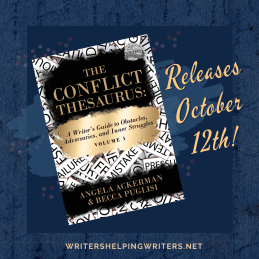 For more help with conflict…
For more help with conflict… Keep your eyes peeled for the upcoming Conflict Thesaurus. Sign up for a release alert here or view sample entries from the book!
The post Does Your Story Need More Conflict? Tap this Powerful Source appeared first on WRITERS HELPING WRITERS��.
Writers Helping Writers
- Angela Ackerman's profile
- 1014 followers



